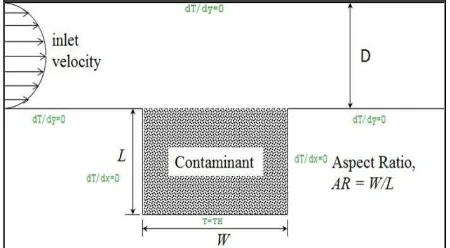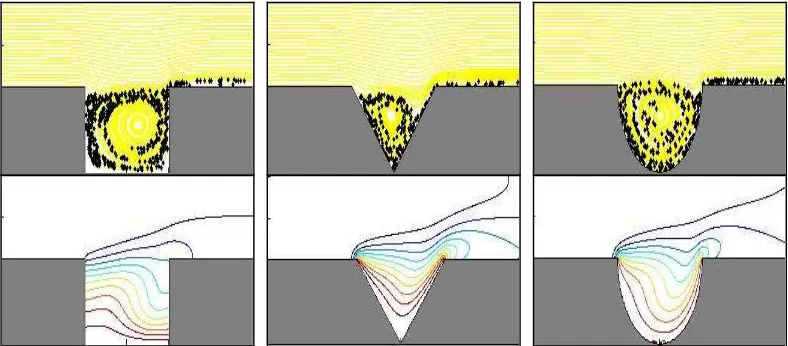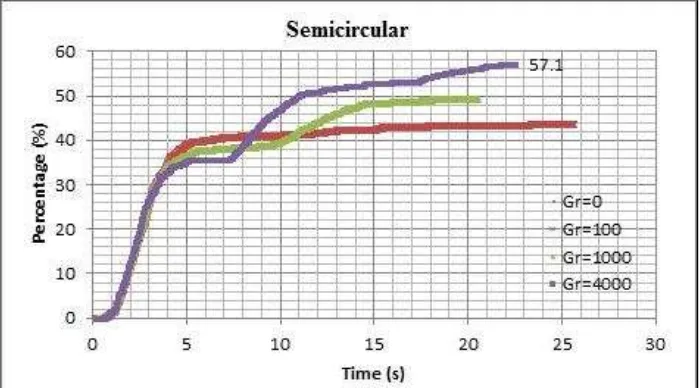Numerical Analysis on the Effects of Cavity Geometry with Heat towards
Contaminant Removal
M.N.A Saadun
1,a, C.S. Nor Azwadi
2,b, M.N. Hazwani
1,cM.S. Zakaria
1,d,
M.Z.A. Manaf
1,e, and M.H. Hanafi
1,f1
Faculti of Mechanical Engineering, UniversitiTeknikal Malaysia Melaka, 76100 Durian Tunggal, Melaka, Malaysia
2
Faculti of Mechanical Engineering, UniversitiTeknologi Malaysia, 81310 Skudai, Johor, Malaysia
a
[email protected], [email protected], [email protected]
d
[email protected], [email protected], [email protected]
Keywords: Cubic Interpolated Pseudo Particle, Solid particle, hydrodynamics removal.
Abstract. Contaminants are recently discovered at the joint of large piping system and causing defect to industrial product. A computational analysis can be used as a solution of the hydrodynamic contaminant removal without any modification needed. In this paper, the effect of heat is introduced to analyze the heat transfer and flow field in a channel with cavity heated at the bottom sides coupled with different shape of cavity. The cavity shape used comes with three shapes i.e. square, triangle and semicircle. The process of fluid dynamic in a cavity is modeled via numerical solution of the Navier–Stokes equations using Cubic Interpolated Profile (CIP) method. By using the simulation of hydrodynamic contaminant removal, the flow of streamlines and vortices pattern was investigated in the cavities. In order to remove all of the contaminant, hydrodynamic need to take part in this simulation which is flow from the inlet of the channel and create vortices to remove it from the cavities. The result shows that the percentage of contaminant removal is higher for semicircle cavity with higher Grashof number. The result also indicates that vortices formation is highly dependent on the cavity geometry and creates a buoyancy effect.
Introduction
The complex structure is the main reason why there is a lack of understanding in phenomenon of solid-fluid interaction. Size of grains or as small as dust pollution can be as solid particle size. Only Tsorng [1] reported complete experimental results on the behavior of solid particles in lid driven cavity flow from the micro-macro particle size. Laser equipment is used in the study to obtain maximum accuracy to capture the high-speed digital image with data interpretation system. Until now most researchers choose simulation approach compared with the experimental approaches to investigate the fluid flow characteristics of these particles because the constraints of cost and inconvenience on the flow characteristics. Extensive numerical results about characteristics of the particles in the flow driven by open cavity to millions of particles in a horizontal pipe expansion have been studied by Kosinski et al [2] [3] [4]. This has been giving back to all the research work installing new prospects in the understanding of fluid solid interaction problems this phenomenon. The combination of the Navier-Stokes continuum has been used by Kosinski et al to predict Newton's second law for solid particles and fluid flow. On the contrary, hydrodynamics cleaning method have been widely accepted as an alternative method for cleaning process in components, parts and pipeline. These matters contribute to accumulate the contaminants and cleaning these lead to a bigger problem. The hydrodynamic removal of a contaminated fluid from a cavity on the duct floor has been reviewed precisely using numerical and experimental method by Fang [5]. Flow past cavities get large attention along last decades in both methods, experimental and numerical investigations. There are various types of cavities shape applied in industrial engineering equipment. Some shape such as rectangular, semicircular and triangular can represent the real application in engineering equipment.
The study of convective heat transfer in the cavity has been increasing over recent years. Simultaneous forced convection and buoyancy convection known as combine or mixed convection, which is a great interest in engineering applications such as reactor lakes, and reservoirs, nuclear, process cooling of electronic devices, solar applications, combustion chambers, food processing and the production of float glass in the industry [6]. There are many convective heat transfers in chemical and food processing industries related to convection heat transfer application. However, there is few studies deal with problems such as hydrodynamic removal under convective heat transfer effects. The main objective of this study is to investigate the flow characteristics of particle dynamics in the cavity and the effect of different forms of cavity with additional heat flux. The combination of different shapes of geometry and convective heat transfer effect will be able to predict the behavior movement of the vortices and streamlines created in the cavity. Thus, the detail understandings of vortices formation location enable researchers and engineers to design the industrial application to more effective for nature contaminant removal.
Mathematical Formulation
For hyperbolic equations, CIP has been proven to be great solution as an alternative method for hyperbolic equation [7-9]. CIP is known as a low numerical diffusion of numerical method to solve advection term only. This method builds a grid cell resolution in close enough to the actual solution [10]. Advection and non-advection was divided from the governing equations and spatial derivatives. In order to solve the non advection term, finite difference method will be used before solving the advection term. Equation of motion of the solid particles is as shown in equation (1) below to predict solid particle dynamics in cavity flow channel.
mass of particle respectively. The drag force given by Kosinski [2] et al can be write as in equation (2).
Ap is the drag coefficient, density and projected area of solid particle respectively. The drag coefficient is given as in equation (3) while equation (4) shows calculation for Reynolds Number.
where dpis the solid particle’s diameter and � is kinematic viscosity of fluid.
Numerical Simulation
(5)
The equation of stream function for the vorticity becomes equation (6).
(6)
The governing equations need to be modified by using dimensionless variables as shown in equation to reduce the number of parameters pertaining to the physical conditions and yet completely describes the behavior of solution. One of the advantages of using dimensionless variables is the value is independent of dimension used. It also convenient to non dimensionalize the governing equation using the following dimensionless variables (7):
, , , , , , , (7)
The simulations of channel flow begin by allocating the solid particle in cavity. The simulations were done at low Reynolds number which is 50 with constant aspect ratio. The low Reynolds number is chosen due to suitability for governing equation that valid for laminar flow and dependency of Grashof number . For heat effect which is related to the Grashof number start with 0, 100, 1000 and 4000 to define as buoyancy force in the cavity. Reynolds number can be defined as in equation (8).
(8)
where , D and
are the maximum inlet velocity, width of the cavity and fluid’s viscosity respectively.
Fig. 1: Physical domain of the problem with boundary condition
Fig. 2: Experimental results (left) simulation (thin lines represent the streamline at steady state)
(right) for particle’s trajectory at Re = 470 [11]
Result and Discussion
Fig. 3 shows the computed streamline for all three geometry at Re = 50. The results in all shapes shows vortex occurrence at the cavity center. As Grashof numbers increase, the main vortex moves towards the cavity and increase the circular. In addition to the main, a pair of counter rotating eddies develop in the corners of the lower cavity and bigger in size for rectangular compared to the semi-circle shape. This figure (Fig. 3) also shows the heat distribution for each cavity after certain period at Gr=4000 to illustrate the buoyancy force.
Fig. 3: Contaminant removal snapshot from cavities at different geometry for Re=50 and Gr=4000
Fig. 4: Particle removals from rectangular cavity at different Grashof numbers at Re=50
percentage for rectangular triangular cavity and lastly Fig. 6 shows the percentage for a semicircular cavity constant Reynolds number of 50. The cavity downstream channel create inertia forces causes solid particles are forced to move and drag it out from the cavity. At low Reynolds numbers, the circulation region is symmetric in all cases and the vortex center is located in the central cavity. Semicircular cavity can produce the highest percentage of contaminants than other cavity as curved cavity depth.
Fig. 5: Particle removals triangular cavity at different Grashof numbers at Re=50
Figure 6: Particle removals from semicircular cavity at different Grashof numbers at Re=50
Conclusion
The structure of the flow and solids removal rate of particles was obtained for three different shapes of the cavity coupled with the effects of convection heat transfer by using state of the art numerical techniques, the CIP and the second law of Newton. Solid-fluid interaction is predicted better using CIP scheme. Results from the work presented in this study shows that heat flux changes have a little influence on the flow structure, particle removal and the cavity shape. For future works, various types of solid fluid flow need to be extended and cover present formulation.
Acknowledgement
The authors wish to thank Universiti Teknikal Malaysia Melaka (UTeM) and Center of Research and Innovation Management (CRIM) through reseach grant PJP/2012/FKM(9A)/S01084 for supporting and funding this research activities.
References
[1] S. J. Tsorng, H. Capart, D. C. Lo, J. S. Lai and D. L. Young, Behaviour of macroscopic rigid spheres in lid-driven cavity flow, Intl. J. Multiphase Flow, 34(2008), 76-101.
[2] P. Kosinski, A. Kosinska and A. C. Hoffmann, Simulation of solid particles behaviour in a driven cavity flow, Powder Tech., 191(2009), 327-339.
[3] C. G. Ilea, P. Losinski, A. C. Hoffmann, Three-Dimensional simulation of a dust lifting process with varying parameters, Intl. J. Multiphase Flow, 34(2008), 869-878.
[4] C. G. Ilea, P. Losinski, A. C. Hoffmann, Simulation of a dust lifting process with rough walls, Chem. Eng. Sci., 63(2008), 3864-3876.
[5] L.C. Fang, J.W. Cleaver, D. Nicolaou, Transient removal of a contaminated fluid from a cavity, Int. J. Heat Fluid Flow 20(1999) 605–613.
[6] T.S. Cheng. Characteristics of mixed convection heat transfer in a lid-driven square cavity with various Richardson and Prandtl numbers. International Journal of Thermal Sciences 50 (2011) 197-20.
[7] H Takewaki, A Nishigushi, T Yabe. Cubic interpolated pseudo particle method for solving hyperbolic type equations. J Comp Phys 1985; 61 (2): 261-68.
[8] C.S. Nor Azwadi, A.R. Mohd Rosdzimin, MH Al-Mola. Contrained interpolated profile for solving BGK Boltzmann equation. Euro J Sci Res 2009; 35 (4): 559-69.
[9] T Yabe, Aoki T. A universal solver for hyperbolic equations by cubic-polynomial interpolation I. One-dimensional solver. Comput. Phys. Commun. 1991; 66 (2):219-32.
[10]C.S. Nor Azwadi, Mohd A.R. Rosdzimin. Cubic interpolated pseudo particle (CIP) - thermal BGK lattice Boltzmann numerical scheme for solving incompressible thermal fluid flow problem. Malay J Math Sci 2009; 3 (2): 183-202.


